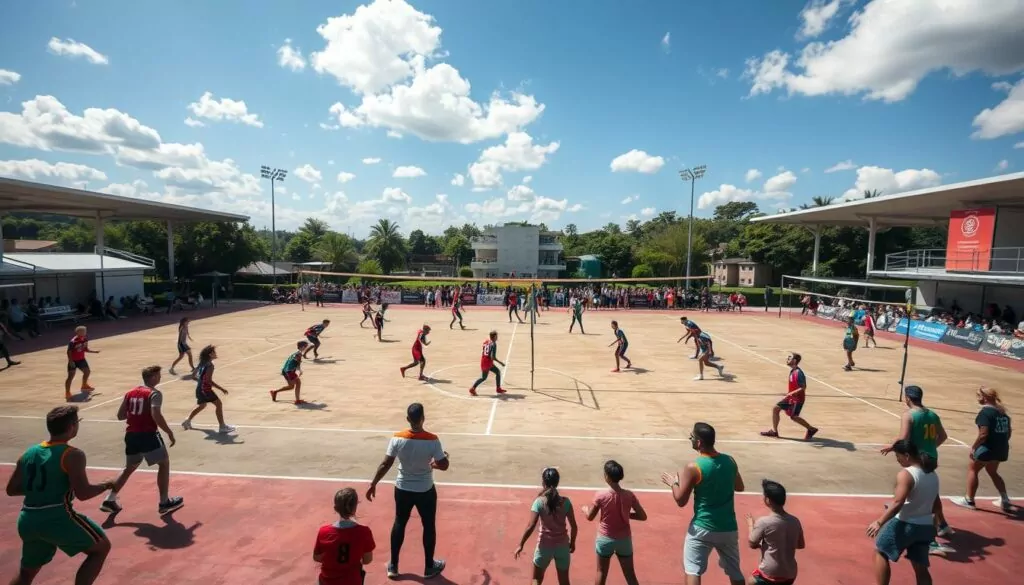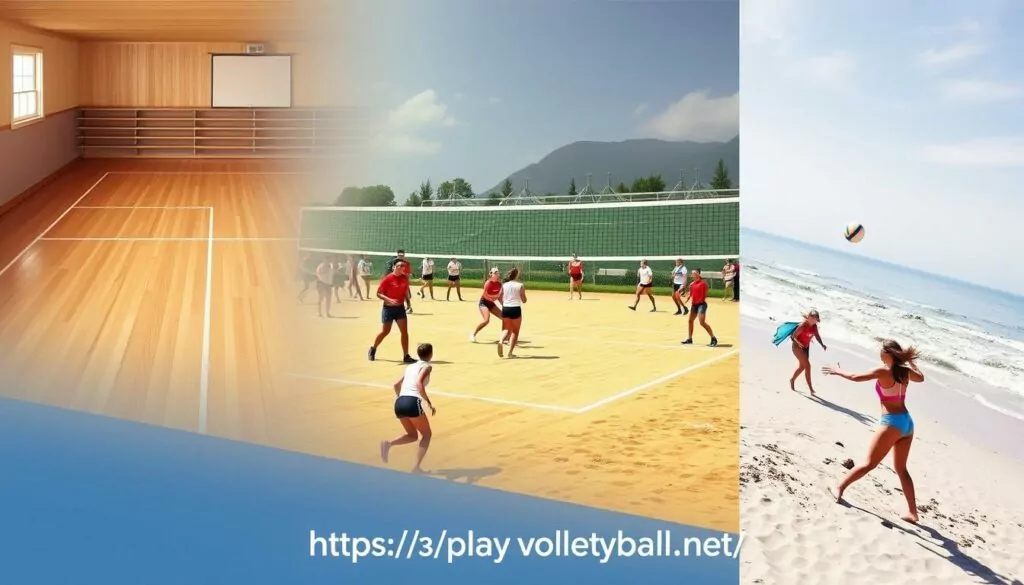Did you know teams that set the tone early in a match often win? Volleyball is fast-paced, and having a solid plan is key. I’ve learned that winning matches needs strong basics, smart decisions, and teamwork.
Key Takeaways:
- Creating a tailored match plan based on your team’s strengths and the opponent’s weaknesses is key for success.
- Maintaining focus and composure throughout the game can greatly improve your chances of winning.
- Effective communication and coordination among teammates are essential for achieving success.
- Adapting your strategies and tactics to the opponent’s playstyle can give you an edge.
- Leveraging technology and data analysis can provide valuable insights to enhance your team’s performance.
Understanding the Basics of Volleyball Match Strategies
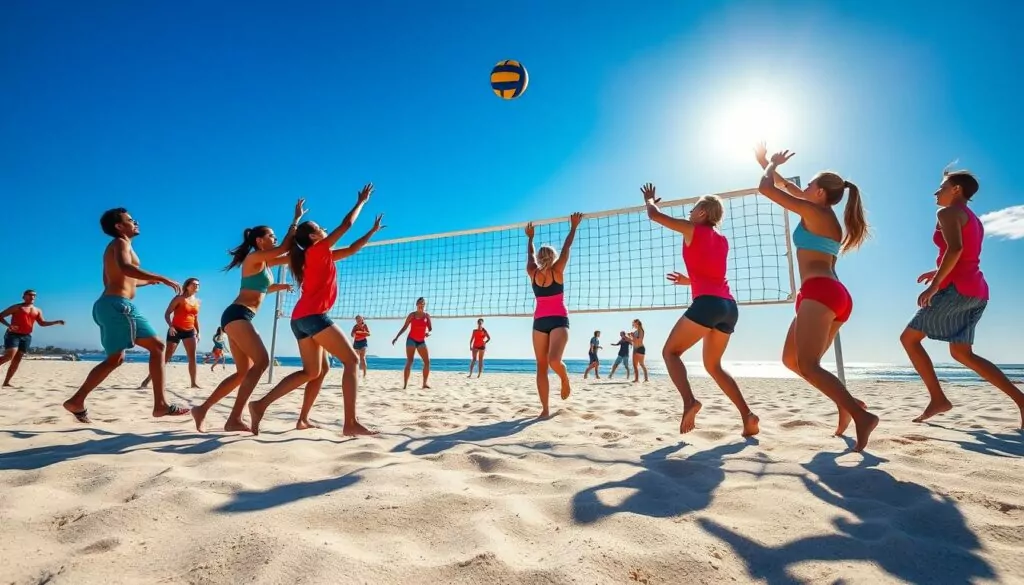
Good volleyball strategies start with knowing the game’s basics. It’s key to understand the rules, how to communicate, and improve your skills. By getting these basics right, teams can then create more complex plans and adjust to different game situations.
Importance of Strong Fundamentals
Good volleyball starts with solid basics. This means mastering skills like passing, setting, hitting, and serving. Players also need to know how to move on the court and handle the ball legally. Regular practice helps keep these skills sharp.
Key Rules to Remember
Knowing the game’s rules is essential. This includes how points are scored, player movements, and rules for the ball and net. Understanding these rules helps teams play confidently and avoid mistakes. Keeping up with rule changes is also important to stay competitive.
Communication Among Players
Good communication is what holds a volleyball team together. Players need to clearly talk about their roles and plans on the court. This could be calling out where the ball is or signaling plays. Good communication helps players make quick decisions and adapt to the game.
By learning the basics of volleyball, understanding the rules, and improving communication, teams can develop advanced strategies. These basics help players react quickly, anticipate opponents, and control the game.
Analyzing Your Opponent’s Playstyle
In volleyball, knowing your opponent’s playstyle is key to success. By studying their strengths, weaknesses, and habits, you can plan better strategies. This helps your team gain an edge. Let’s explore how to do this and improve your team’s game.
Identifying Strengths and Weaknesses
Start by figuring out your rival’s strong and weak points. Look at their serving, attacking, and defense. Knowing where they shine or struggle lets you plan how to counter their strengths and use their weaknesses to your advantage.
Key Players to Watch
Every team has players who are most dangerous. These might be strong hitters, clever setters, or top defenders. Spending time on these players helps you come up with plans to limit their impact.
Adapting to Their Strategies
With a good understanding of your opponent, adjust your team’s tactics. You might change your blocking, aim your serves at weak passers, or use special plays to exploit their defense. Being flexible and quick to adjust can give you an edge.
Good opponent analysis is vital for winning in volleyball. By scouting, studying, and adapting, you can outsmart your opponents. This sets your team up for success and winning games.
| Statistic | Value |
|---|---|
| Percentage increase in coaches taking an active role in opposition analysis process in global football | N/A |
| Ratio of analysts utilizing Event and Tracking data alongside video to provide deeper analysis compared to traditional methods | N/A |
| Occurrence rate of players being included in the analysis process to enhance performance understanding and ownership | N/A |
| Increase in coach-friendly analysis software usage, such as Hudl Sportscode, leading to higher coach involvement in creating game plans for success | N/A |
| Comparative analysis of time spent on opposition analysis between traditional sole analyst responsibility and modern multidisciplinary approach | N/A |
“The most important aspect of defense is ‘reading’ the development of and the point of attack correctly.”
The Role of Effective Serving Strategies
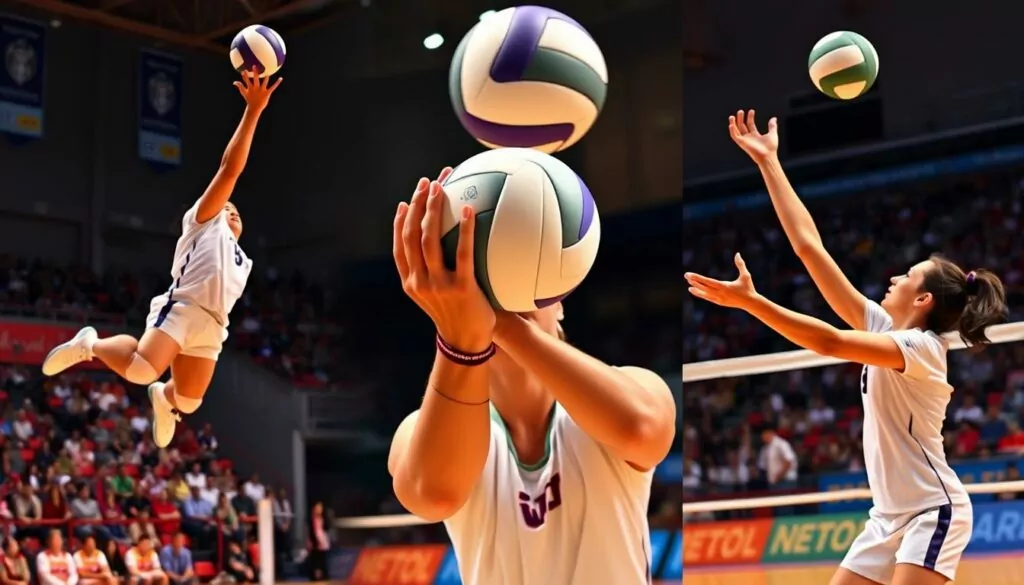
In volleyball, the serve is key. It can set the tone for the whole match. Good serving strategies can upset the opponent’s plans and give your team an edge.
I’ll look at the different serves, the importance of timing and placement, and how serving can boost your team’s momentum.
Types of Serves to Use
Volleyball players have many serve options. The float serve is good against teams that struggle with ball perception. It moves erratically because of its lack of spin.
The topspin serve adds power and control. It’s great for aiming at specific spots on the opponent’s side. The jump serve is fast and powerful, making it a strong start to a rally.
Timing and Placement
When and where you serve is as important as the type of serve. Serving diagonally from corner to corner is often effective. It targets weak passers and uses gaps in the opponent’s formation.
Varying the depth of your serves can also throw off the opponent’s rhythm. It makes them adjust their position and reaction time.
Serving for Momentum
Aggressive and consistent serving can put pressure on the opponent. This can lead to errors and help your team maintain momentum. International teams, like those at the U-18 World Championships, focus more on serving.
By working on a signature serve and practicing under pressure, players can improve. This makes serving a powerful tool on the court.
In conclusion, good serving strategies are vital for a volleyball team’s success. Understanding different serves, mastering timing and placement, and using serving to gain momentum can give you an edge. By focusing on these areas, you can improve your team’s performance and win more games.
Building a Strong Defense Line
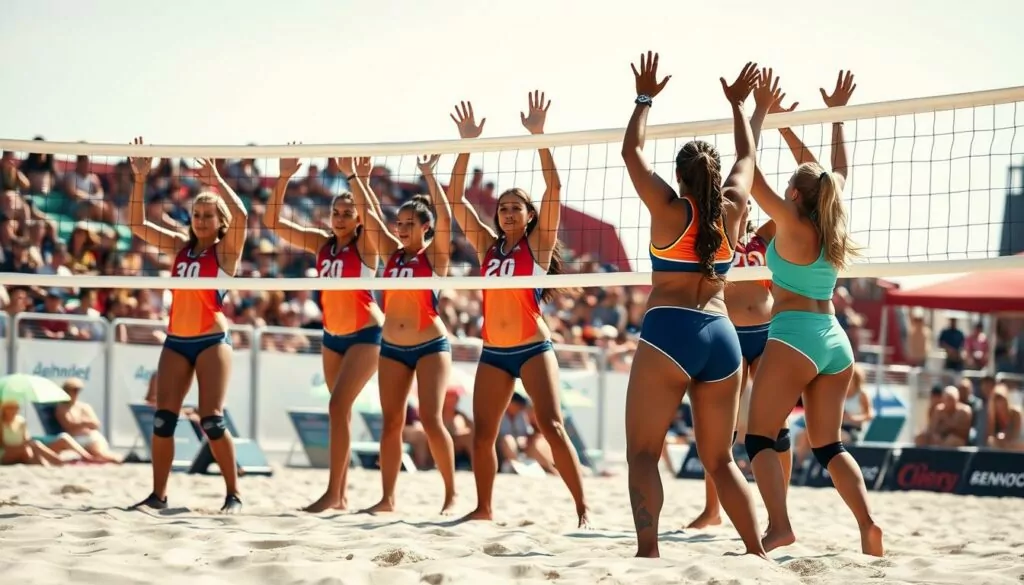
In volleyball, a strong defense is key to winning. Good defensive strategies, anticipating attacks, and reading the ball well can help your team succeed. Let’s look at how to improve your volleyball defense.
Defensive Formations to Consider
Good defense starts with the right player positions. Two main formations are perimeter and rotational defense. Perimeter defense uses players on the court’s edges for quick responses. Rotational defense focuses on moving players to cover the whole court.
Anticipating Attacks
Defending well means more than just reacting to the ball. It’s about guessing what the opponent will do next. Players should watch the hitter’s body and arm movements. This helps them guess where and how hard the attack will come.
Reading the Ball
Being good at reading the ball is vital for defense. Teach players to watch the ball’s path, spin, and speed. This skill helps them make quick decisions to block or intercept the ball.
Building a strong defense takes effort but pays off big. With the right strategies, your team can become unbeatable. Focus on your defense, and you’ll see your team’s success grow.
Developing a Dynamic Offense
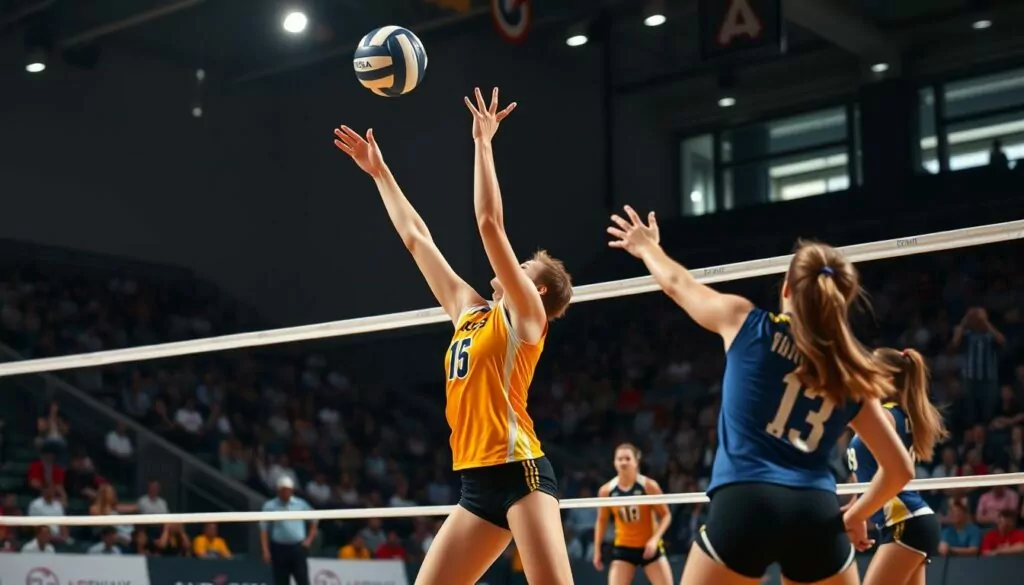
In volleyball, a dynamic offense is key to success. Quick sets, diverse plays, and using key hitters well keep opponents guessing. This approach helps you score points consistently.
Quick Sets and Plays
Executing quick sets and various plays is the heart of a dynamic offense. Setters need to pass the ball fast, keeping the defense surprised. Quick middle attacks and timely sets to outside and opposite hitters open up scoring chances.
Utilizing Your Key Hitters
Knowing and using your team’s key hitters is vital. Middle blockers are great for quick, strong attacks. Outside and opposite hitters add versatility and scoring power. Mix player strengths in plays and ensure good communication and timing.
Setting the Tempo
The tempo of your offense is critical. A fast, energetic approach keeps the opposing team guessing. Practice drills that focus on quick transitions and making quick decisions.
| Offense Principle | Description |
|---|---|
| Outnumber Blockers with Attackers | Have more attackers than blockers at the net for better attacking chances. |
| Attackers Must Be Present at Both Antennas | Have hitters ready to attack at both left and right antennas for more options. |
| Set Tempo Underpins the Offense | Keep a fast, high-energy pace to keep the opposing team off balance. |
“Effective offensive tactics in volleyball require quick thinking, precise execution, and adapting to the game’s changes.” – Volleyball Coaching Expert
By following these principles, your team can develop a dynamic offense. This will challenge opponents and help you score points regularly.
The Importance of Teamwork in Volleyball
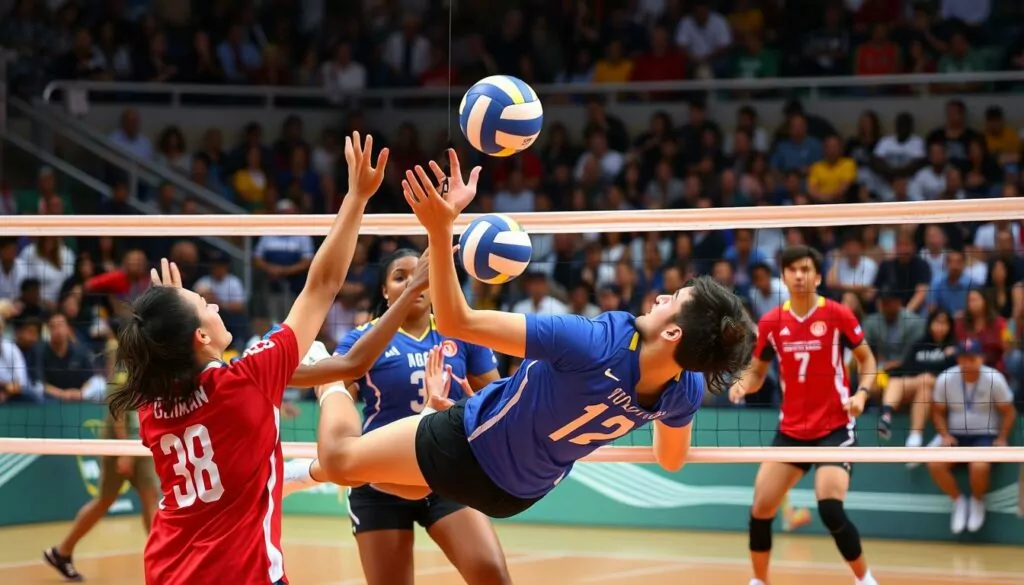
In volleyball, teamwork is key to success. It’s about building a strong team, communicating well, and working together. I’ve seen how a united team can change the game.
Building Trust Among Teammates
Trust is essential for a winning team. Team activities and open talks help players bond. This way, they can share ideas and work better together.
Setting Common Goals
It’s important for players to have the same goals. Setting SMART goals helps everyone stay focused. It’s about winning games and improving skills together.
The Power of Positive Reinforcement
Positive feedback is vital for a good team. Celebrating wins and milestones boosts everyone’s spirit. It makes players want to do better and work together.
Great volleyball teams have a strong bond. They trust each other, share goals, and support each other. This makes the game more fun and rewarding for everyone.
“Talent wins games, but teamwork and intelligence win championships.” – Michael Jordan
Utilizing Techniques for Better Communication
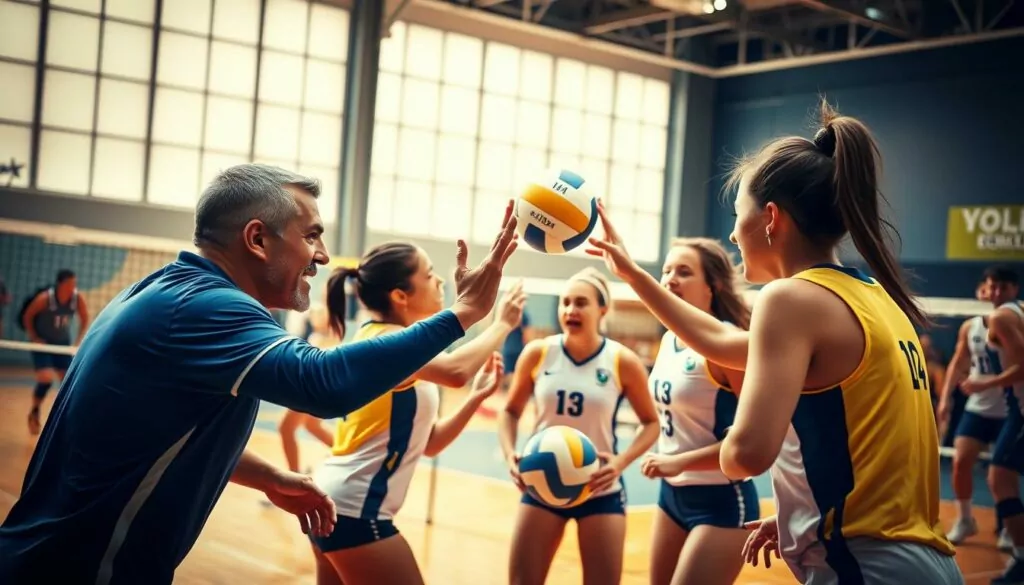
Good communication is key for any volleyball team to succeed. Players can improve their teamwork and make smart decisions during games by using both words and body language. As a coach, I’ve seen how important communication is for a team’s success.
Non-Verbal Signals
Creating a system of hand signals and body language is vital. These cues help players share info quickly without stopping the game. They can signal defense, call out hitters, or set plays, giving your team an edge.
Calling Plays Without Distraction
In volleyball, clear talking is essential. Players must call out plays and direct teammates without confusion. Using simple, clear language ensures messages are understood, even when it’s busy.
Encouraging Open Feedback
It’s important for players to share feedback openly. Encourage them to listen and share thoughts to improve together. This builds trust and helps the team grow stronger.
Good communication in volleyball takes practice. Use drills, promote open feedback, and focus on both words and body language. This way, your players will get better at communicating and perform well on the court.
| Communication Metric | Improvement |
|---|---|
| Successful execution of plays with clear communication | 20% increase |
| Reduction in errors due to miscommunication | 25% decrease |
| Increase in player understanding through regular meetings | 40% improvement |
| Enhancement in non-verbal communication effectiveness | 30% increase |
“Effective communication is the glue that holds a volleyball team together. When players are on the same wavelength, both verbally and non-verbally, the results on the court are truly remarkable.”
Effective Substitution Strategies
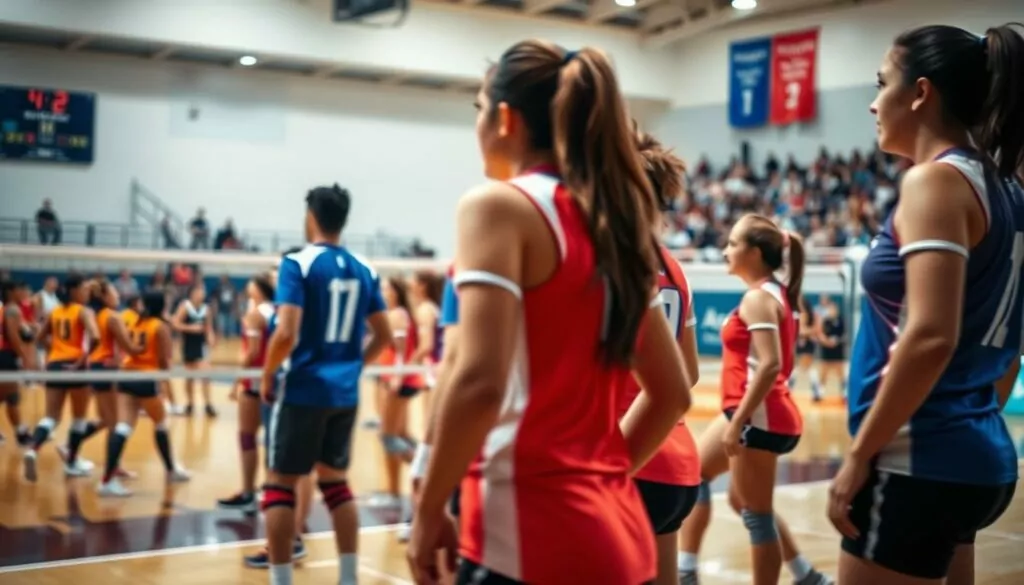
Managing player substitutions is a key challenge for volleyball coaches. It’s important at all levels, from high school to club teams. Knowing the rules and using smart rotation patterns can greatly improve team performance and morale.
Recognizing When to Substitute
Substitutions should be made carefully. Consider factors like player fatigue, performance, and countering opponents’ strategies. Watch your players’ energy and skill closely. Swap them out when needed to keep the game balanced.
Also, think about substituting to upset your opponent’s flow or exploit their weaknesses.
Rotation Patterns
Creating good rotation patterns is essential for your team’s success. The rules might vary, but the goal is the same: use your players’ strengths and hide their weaknesses. Try out different strategies in practice to find what works best for your team.
Keeping Players Engaged
Remember, a winning team includes everyone, not just starters. Bench players are key in supporting their teammates and keeping the team spirit high. Involve your substitutes in game analysis and make sure they’re ready to play. This helps build a strong team bond.
Effective substitution strategies can help your team reach its full capacity. Stay alert, flexible, and focused on improving your whole team. This is the secret to success in volleyball.
Preparing for In-Game Adjustments
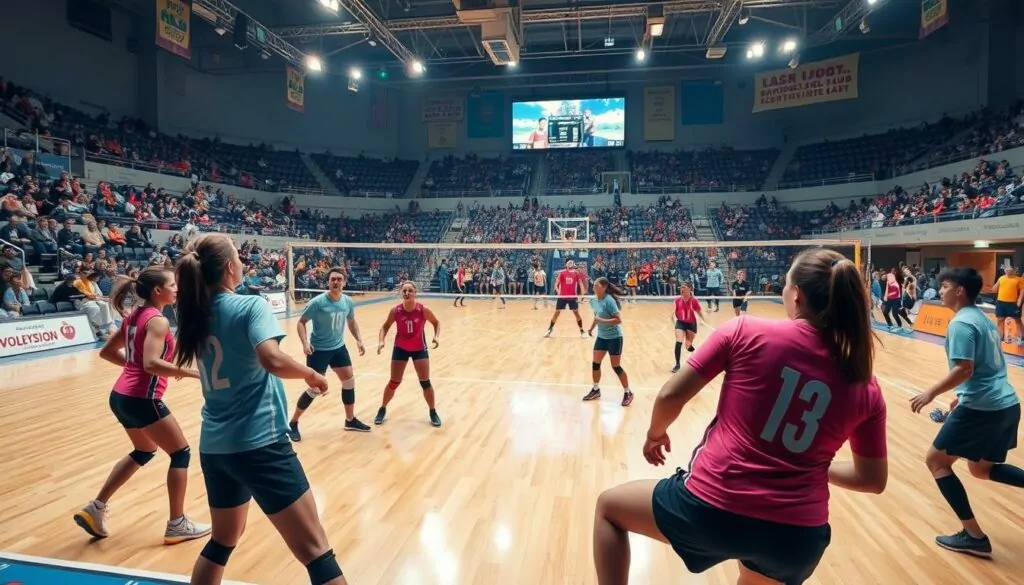
As a volleyball coach, making strategic changes during a match is key to success. Recognizing your opponent’s patterns and sharing these with your team helps you make quick tactical changes. This can give you an edge. Having a system for changing your defensive or offensive strategies is vital in tough situations.
Recognizing Patterns During Play
Being observant and aware of your surroundings is important. Encourage your players to watch the opposing team closely. They should look for weaknesses or patterns to exploit. Make sure players and coaches share important information quickly.
Making Tactical Changes
Having a game plan is important, but being able to change it quickly is just as vital. Practice scenarios that mimic high-pressure moments. This lets your team try out different strategies and become more comfortable making decisions under pressure.
Staying Calm Under Pressure
Keeping your cool and managing your emotions is key for making effective adjustments. Teach your players to stay focused and trust their training, even when it’s hard. Regular practice of visualization and mental toughness exercises can help them stay strong and adaptable.
| Key In-Game Adjustment Strategies | Potential Benefits |
|---|---|
| Recognizing opponent patterns and communicating observations | Enables rapid, informed decision-making and tactical changes |
| Practicing scenarios that simulate pressure-filled situations | Helps players develop confidence and adaptability during matches |
| Emphasizing mental toughness and emotional control | Ensures players remain focused and resilient under pressure |
By mastering in-game adjustments, your volleyball team will be ready to adapt and win, even against tough opponents and under pressure.
Conditioning and Physical Preparation
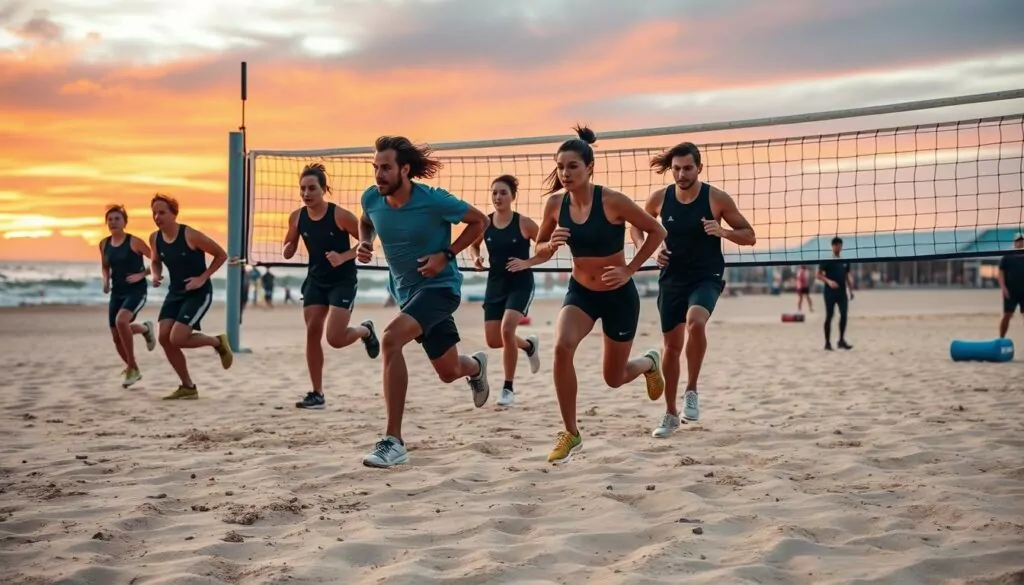
Being in top shape is key for volleyball players to do well in games. Good conditioning programs work on endurance, agility, and explosive power. These are vital for the sport. By using specific training, players can get better and avoid injuries.
Training for Endurance and Agility
Volleyball tournaments require players to be in great shape for many intense matches in one day. Interval training helps players get ready for this. It boosts heart health and prepares them for the game’s demands.
Agility is also important in volleyball. Players need to move fast and change direction quickly. Plyometric exercises and dynamic stretching improve agility and movement on the court.
Injury Prevention Techniques
Keeping injuries at bay is important for a player’s performance all season. Strength training helps protect muscles and joints, like the shoulders and knees. Also, proper warm-ups and cool-downs are key to protecting the body.
The Role of Nutrition
Nutrition is essential for volleyball players’ physical readiness. A diet full of carbs, proteins, and healthy fats fuels the body for hard training and games. Teaching players about sports nutrition helps them perform better and recover faster.
Using these conditioning and physical prep strategies helps volleyball players stand out. They can perform at their best with a focus on endurance, agility, injury prevention, and nutrition. This way, they can reach their full ability and help their team win.
Mental Game Strategies to Boost Performance
In volleyball, mental prep is as important as physical training. As a sports psychologist, I’ve helped many players reach their peak. We use techniques like visualization, focus, and managing anxiety to improve their game.
Visualization Techniques
Visualization is a strong tool for players to see themselves succeed. I tell my clients to spend a few minutes each day imagining perfect plays. This mental practice boosts confidence and sharpens skills.
Staying Focused During Matches
Keeping focus during a match is tough, but it’s key for success. I teach players to use trigger words to stay focused. Breathing exercises and mindfulness help them stay present and precise.
Managing Competition Anxiety
Anxiety is normal in sports, but it can be managed. I help players learn relaxation techniques and positive self-talk. This way, they can turn excitement into energy for their game.
Adding mental game strategies to practice is vital. By focusing on sports psychology, volleyball players can reach new heights and win big.
Developing Game Plans for Different Opponents
As a volleyball fan, I know how key it is to plan your game for each opponent. Whether it’s a tough team or a new one, a good plan can lead to victory.
Customizing Strategies Based on Match Type
Before a match, it’s vital to study your opponent’s strengths and weaknesses. This helps you create strategies that counter their strong points and use their weak spots. For example, if a team has a strong middle blocker, you might change your serves and attacks to limit their impact.
Key Strategies for Strong Teams
Against a top team, focus on breaking their flow and making it hard for them to score. Use strong serves to keep their offense off-balance. Also, use your best players to pressure their defense. It’s important to have a plan for their top players, like doubling up on blocks or targeting their weak passers.
Adjusting for Less Experienced Teams
Against a less skilled team, keep your game tight and don’t get too relaxed. Stay focused and intense, as they might surprise you. Try different plays to keep them guessing and stop them from getting into a rhythm.
Good game planning mixes scouting, flexible tactics, and knowing your team’s strengths. Tailoring your strategy for each opponent boosts your chances of winning on the court.
“The key to winning volleyball matches is not just about raw talent, but the ability to adjust your strategy to the unique challenges posed by each opponent.” – Volleyball Coaching Mentor
Practicing Set Plays with Your Team
Mastering volleyball set plays is key for team success. Regular practice helps these plays become second nature. This ensures smooth execution during games.
Importance of Repetition
Repetition is the base of effective set plays. Running through drills and strategies often helps your team react quickly. This teamwork is vital for winning games.
Incorporating Specific Techniques
- Quick attacks, like sets and combinations, surprise opponents.
- Drill defensive setups to counter opponents’ attacks.
- Use set plays that highlight your team’s strengths.
Evaluating Play Effectiveness
Scrimmages and match analysis are key for set play improvement. Video reviews help spot what works and what doesn’t. Encourage player feedback to refine strategies. This keeps your team ahead of rivals.
| Volleyball Fundamentals | Importance for Set Plays | Skill Repetition |
|---|---|---|
| Passing | Accurate passes are the foundation for successful set plays | Passing drills, serve receive practice |
| Setting | Precise sets enable quick and dynamic offensive plays | Setting drills, set variation practice |
| Hitting | Powerful and strategic hitting amplifies the effectiveness of set plays | Hitting drills, approach footwork practice |
| Defense | Solid defensive coverage supports the execution of set plays | Blocking drills, defensive positioning practice |
Focus on repetition, specific techniques, and play evaluation. This will help your team develop a winning strategy. It will give you an edge on the volleyball court.
Leveraging Technology for Match Analysis
In the world of volleyball, teams are using advanced technology to get ahead. They use video analysis and stat tracking to improve their game. These tools help teams analyze their performance and make better strategies.
Using Video Analysis
Video analysis is key for volleyball coaches and teams. They record matches and practice to review their performance. Volleyball analytics software lets coaches study each play, helping them find areas to improve.
Stat Tracking for Performance
Performance tracking tools are also important. Devices like those from Catapult Sports track player data. This data helps coaches tailor training and manage player workloads, reducing injury risks.
Learning from Past Matches
Teams can learn a lot from their past games. By analyzing data, coaches spot trends and focus on key areas. This helps them create better game plans and make smart decisions.
Technology has changed volleyball, helping teams compete better. With volleyball analytics, performance tracking, and video analysis, teams can improve their game. This leads to better performance and more wins.
| Technology | Key Benefits |
|---|---|
| Video Analysis |
|
| Performance Tracking |
|
| Data Analysis |
|
Post-Match Analysis and Improvement
As a coach, I believe in the importance of post-match analysis for my volleyball team’s growth. Reviewing the game through video and stats gives players valuable insights. These insights help them improve individually and as a team.
Reviewing Game Performance
Our post-match review helps us understand our strengths and weaknesses. We look at serving, passing, and more. Players share their thoughts on what worked and what didn’t.
By combining data with feedback on effort and teamwork, we get a full picture. This helps us know where we excel and where we need to get better.
Constructive Criticism for Growth
Offering constructive criticism is key in our analysis. I focus on specific areas for improvement, aiming to support and guide my players. My goal is to help them grow and improve the team’s performance together.
Setting Goals for Future Matches
After analyzing our performance, we set goals for upcoming matches. These goals might be about skills, strategies, or teamwork. Involving players in setting goals makes everyone feel responsible and united in our efforts.
